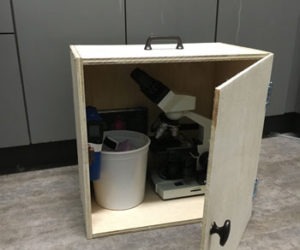Build an Apple Scratter

For years I would head to orchards, pick from my backyard trees and even shake apples loose from the wild trees in the woods. I borrowed a friend’s old fashioned, single-tub press with a hand-cranked grinder or “scratter” to pulp the fruit and squeeze out the juice using a long screw pressing down into a bucket. Every year I would notice how the scratter would create large chunks of apple in the tub that would remain moist even after turning the pressing screw and a using “persuader” (often an old wooden baseball bat) for extra leverage. I figured there had to be a better way. This is the point when tradition was aided by modern technology.
I started researching how production cideries grind their apples and found that it usually doesn’t involve some old-timer hand cranking a cylinder with small teeth to break up the apples. In fact, most large-volume cidermakers use an industrially designed, motorized pulverizer. This led me to a small-scale, innovative farmer based in upstate New York who fashioned a 1 horsepower electric farm motor to a disassembled garbage disposal to grind up apples for cider pressing. I first became aware of Herrick Kimball through his home-designed chicken plucker, as I raise broiler chickens every summer. After building a plucker based on his plans, I knew that he was onto something. When I found that he was also a backyard cidermaker, I was pleased to see he had re-thought the old fashioned grinder into a modern version to produce higher yields and with less effort. While Mr. Kimball re-powered his disposal with a separate motor and connected them by a belt, I figured that after spending approximately $100 on a new disposal, why would I remove the built-in motor?
Luckily it has worked for many years and I am able to produce an almost applesauce consistency for pressing in my homemade rack and cloth cider press. In fact, compared to the old days of hand cranking, I’m able to produce almost twice the amount of cider from the same weight of apples.
Materials and Tools:
~ 20 feet (6 m) 2×4 lumber
~ 18-inch by 18-inch (45-cm by 45-cm) piece of countertop (or plywood)
Garbage disposal
Light switch
Weatherproof light switch housing
Potable water plumbing pipe with friction fitting for outlet
6-8 inches of 1×1 wood trim
6 inches of 1⁄4-inch round stock
12 feet (3.7 m) 14-gauge outdoor rated extension cord
Power drill
Jigsaw


